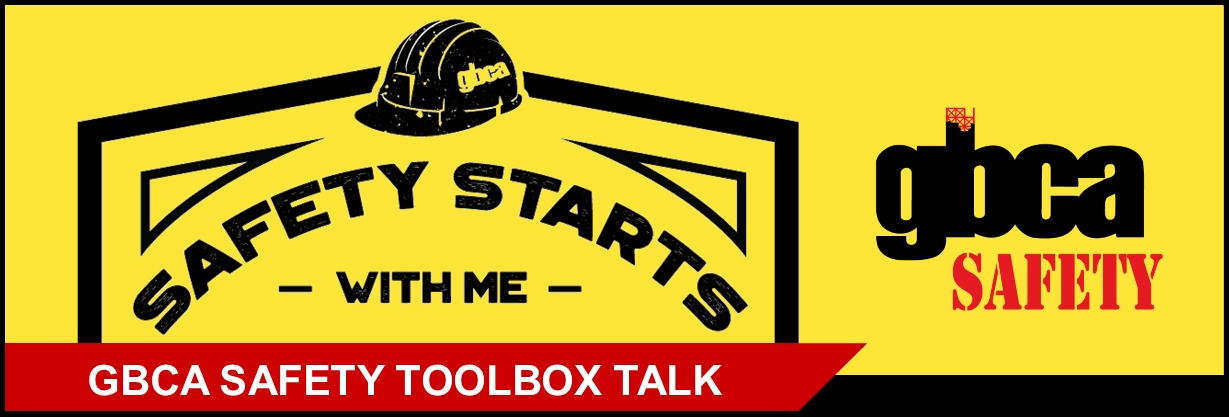This GBCA Safety Toolbox Talk discusses scaffold foundations, and requirements for competent persons assessing foundations before using scaffolds. Click below to download the Toolbox Talk as a handout (includes Sign-In Sheet).
Scaffold Foundations
Scaffolding is only as good as its foundation. Scaffolds are temporary platforms used in the construction industry that allow workers to access higher levels. Supported scaffold is a scaffold system set on ground level with built in levels to increase its height. No matter how high it is set, the scaffold must be set on a good foundation. This toolbox talk goes over OSHA’s requirements for a good foundation, scaffold components for a scaffold system, and what to look for in a scaffold system foundation before getting onto a scaffold.
Supported scaffold poles, legs, posts, frames, and uprights shall bear on base plates and mud sills or other adequate firm foundation. (1926.451(c)(2))
Adequate Foundation
An adequate foundation is one that, like base plates on mud sills, will prevent the scaffold from settling into the ground. A firm foundation, such as a flat, level concrete slab, is an adequate surface for a base plate.
Base Plate
A base plate is a device that spreads the point load of the scaffold frame over a larger area. This keeps the frame from sinking into the ground.
Mud Sill
A mud sill is a device that further extends the point load of the base plates. The purpose of the mud sill under the scaffold base plate is to uniformly distribute the scaffold load over a larger area than that distributed by the base plate alone, thereby reducing the loading on the ground beneath the base plates.
Scaffold frames on the first level must be set on base plates, and mud sills if set up on un-firm surfaces such as soil or gravel.
The scaffold base plates and mud sills increase the area where the downward forces of the scaffold are transmitted. The scaffold load is transferred from the uprights to the base plates and then to the mud sills or other adequate foundation from the scaffold legs, which must show minimal or negligible settlement under a full scaffold loading to be adequate.

Foundation Requirements for Scaffolds & Competent Person Qualifications for Assessing Foundations
The OSHA standard recognizes that certain foundations may be of adequate firmness to support a scaffold without the use of mud sills. Generally, the adequacy of a foundation to support a scaffold cannot be determined in the abstract because of the numerous factors which may exist at a work site. Concrete is the lone exception to this rule, which, because of its structural properties and strength, OSHA has determined constitutes a firm foundation.
In all cases a competent person must inspect and approve the foundation (daily).
Compacted Soils & Then Frozen
Compacted soils, as with all soils, swell and heave due to moisture content or water contained within the soil. This creates a dangerous situation during the freeze/thaw cycle (which can occur in the course of a day) causing the soil to swell or settle and may not result in a level rigid footing. The competent person must inspect the area to determine if this is a firm footing. Then this must be inspected when conditions change, such as sunny conditions, warming temperatures, etc.
Cold Asphalt Paving (Winter)
Asphalt has minimal compressive strength, even when cold, and especially when applied. By itself it is not normally a useable foundation material.
Hot Asphalt Paving (Summer)
This type of asphalt (top coat) is soft when placed and then compacted with rollers. It is generally applied as a thin coat over a base coat and takes several days to achieve its designed strength. Only the base coat gives the asphalt compressive strength.
Wood Decking
This may lend itself for use as a foundation. However, an evaluation of the deck for its maximum allowable loading would be required, since the decking or deck structure could fail under a full scaffold load. The competent person would need to know the individual scaffold base plate loading and if each one is below the maximum allowable deck loading. A light weight supported scaffold could be used on wood decking when the competent person has determined the structure would support the scaffold and its entire load.
Compacted Gravel Roads
This type of road surface may have adequate strength but the material does not provide a smooth surface. Additionally, there is no material cohesion; during a storm the material can wash away under the scaffold base plates.
In each of the examples cited, some type of settlement or displacement could occur when used without mud sills. The foundation where the scaffold would be erected must be evaluated in the pre-job planning. This determination is extremely important to the erection, use and dismantling of the scaffold. The determination must be made by a competent person with the knowledge of the type of scaffold, the expected live and dead loads, and the weather conditions for the area.
Remember to record the attendees of your toolbox talk!





